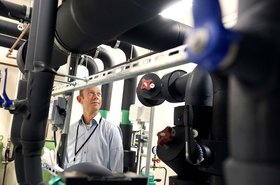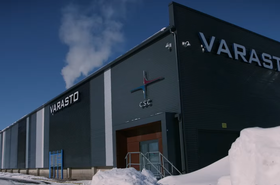Amazon Web Services' recently completed data center in Dublin is to supply recycled heat to Heatworks, South Dublin District Council’s (SDDC) newly established district heating company.
The heat - in the form of water heated via a heat exchanger - will be provided free to the not-for-profit company, which was set up with financial support from the EU's Inter-Reg NWE program, called HeatNet. The company runs the Tallaght District Heating Network, in the Tallaght district south-west of Dublin.
Hot stuff
The scheme will begin supplying heat before the end of next year, providing heat to 47,000 square meters of public-sector buildings, 3,000 square meters of commercial office space, and 135 ‘affordable’ apartments by 2024. Buildings that will benefit include SDDC’s County Hall, the Civic Centre, the Technological University Dublin, and Tallaght County Library.
It’s not clear what other inputs the scheme will have from industry, although South Dublin has become a key data center hub in Ireland. The state-owned electricity company was recently forced to provide extra supply to the area to meet an anticipated doubling in demand for power caused by the rapid growth of the industry.
The heat from AWS’s data center will be drawn from its hot aisle and run through a heat exchanger that both cools the data center and heats up water that is delivered to a nearby heat pump, operated by Heatworks.
A number of schemes have been developed in recent years to make better use of data centers’ exhaust heat and, thereby, to improve their sustainability. These include Blockheating’s containerized Edge data centers that can be used to warm greenhouses. However, district heating remains the main way of recycling heat generated by data center servers.
The Tallaght district heating scheme - the first of its kind in Ireland - was originally devised in 2018. The scheme is expected to reduce carbon dioxide emissions by just under 1,900 tonnes per year. Heatworks has contracted Finnish energy supply company Fortum to design, install, and manage its district heating network.
District heating is, theoretically, more efficient than heating individual homes as both heat and electricity can be generated at the same time in combined heat and power (CHP) plants, which recover heat that a conventional power station would simply vent. Organizations can also contribute to the network, improving efficiency.
While district heating schemes are not widely deployed across the world, they have proved popular in parts of Scandinavia (excluding Norway), Germany and Austria. District heating was also implemented across the former Soviet Union and Communist Eastern Europe, typically powered by coal or natural gas CHP plants. Residents, however, would often have to wait for the authorities to turn on the heating in winter.
Homes in Iceland, meanwhile, are 95 percent heated by district heating services, but via geothermal schemes.




